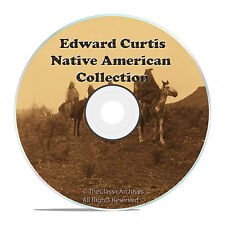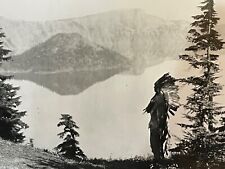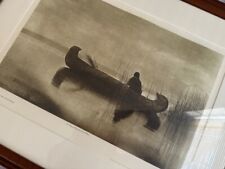When you click on links to various merchants on this site and make a purchase, this can result in this site earning a commission. Affiliate programs and affiliations include, but are not limited to, the eBay Partner Network.
EDWARD CURTIS SIGNED OROTONE ORIGINAL ANTIQUE BAT WING FRAME “MAID OF DREAMS” GOLD TONE IMAGE SIZE 5 X 7 INCHES BAT WING FRAME SIZE 6.25 X 8.25 INCHES. IN NEAR PERFECT CONDITION; THE IMAGE IS A LITTLE LIGHTER THAN SOME OF THE OTHER LARGER “MAID OF DREAMS” THAT I HAVE SEEN. THERE IS ONE TINY IMPERFECTION IN THE PLATE WHEN IT WAS MADE WHICH IS ALMOST IMPERCEPTIBLE. A TINY SPECK IN THE UPPER RIGHT HARD CORNER. NEARLY ALL CURTIS OROTONE HAVE SOME FORM OF IMPERFECTION. A BRIGHT CLEAN IMAGE IN AN EXTREMELY OLD AUTHENTIC ANTIQUE ORIGINAL BAT WING FRAME! THIS IS A RARE AND UNUSUAL PIECE THAT WOULD BE A HONOR TO HAVE IN ANY COLLECTION. ALL THE BEST TO YOU AND YOURS AND THANKS FOR LOOKING. PLEASE SEE THE OTHER ITEMS THAT I HAVE UP FOR sale. GOOD LUCK TO THE HIGHEST buyer! THANK YOU… DAVE
Edward Curtis was born on February 16, 1868 on a farm nearWhitewater, Wisconsin.His father, theReverendAsahel \"Johnson\" Curtis (1840–87), was aminister, farmer, andAmerican Civil Warveteran[5]born inOhio. His mother, Ellen Sheriff (1844–1912), was born inPennsylvania. Curtis\'s siblings were Raphael (1862–c.1885), also called Ray; Edward, called Eddy; Eva (1870–?); andAsahel Curtis(1874–1941).[3]Weakened by his experiences in the Civil War, Johnson Curtis had difficulty in managing his farm, resulting in hardship and poverty for his family. Around 1874, the family moved fromWisconsintoMinnesotato join Johnson Curtis\'s father, Asahel Curtis, who ran a grocery store and was a postmaster inLe Sueur County.[3][5]Curtis left school in thesixth gradeand soon built his own camera.
Early career
Princess Angeline(Duwamish) in an 1896photogravureby Edward Sheriff Curtis
In 1885 at the age of 17, Edward became anapprenticephotographer inSt. Paul, Minnesota. In 1887 the family moved toSeattle, Washington, where Edward purchased a new camera and became a partner in an existing photographic studio with Rasmus Rothi. Edward paid $150 for his 50% share in the studio. After about six months, Curtis left Rothi and formed a new partnership with Thomas Guptill. The new studio was called Curtis and Guptill, Photographers and Photoengravers.
In 1895, Curtis met and photographedPrincess Angeline(c. 1820–1896), aka Kickisomlo, the daughter ofChief SealthofSeattle. This was to be his first portrait of aNative American. In 1898, three of Curtis\' images were chosen for an exhibition sponsored by theNational Photographic Society. Two were images of Princess Angeline, \"The Mussel Gatherer\", and \"The Clam Digger\". The other was of the Puget Sound, titled \"Homeward\". The latter was awarded the exhibition\'s grand prize and a gold medal.[6]In that same year, while photographingMt. Rainier, Curtis came upon a small group of scientists. One of them wasGeorge Bird Grinnell, an expert on Native Americans. Curtis was appointed Official Photographer to theHarriman Alaska Expeditionof 1899, probably as a result of his friendship with George Bird Grinnell. Having very little formal education Curtis learned much during the lectures that were given aboard the ship each evening of the voyage.[7]Grinnell became interested in Curtis\' photography and invited him to join an expedition to photograph people of theBlackfoot Confederacyin Montana in the year 1900.[2]
The North American Indian
The North American Indian, 1907
In 1906,J. P. Morganprovided Curtis with $75,000 to produce a series on Native Americans.[8]This work was to be in 20 volumes with 1,500 photographs. Morgan\'s funds were to be disbursed over five years and were earmarked to support only fieldwork for the books not for writing, editing, or production of the volumes. Curtis himself would receive no salary for the project,[9]which was to last more than 20 years. Under the terms of the arrangement, Morgan was to receive 25 sets and 500 original prints as his method of repayment.
Once Curtis had secured funding for the project, he was able to hire several employees to help him. For writing as well as with recording Native American languages, Curtis hired a former journalist, William E. Myers.[9]For general assistance with logistics and fieldwork, Curtis hired Bill Phillips, a graduate of theUniversity of Washington. Perhaps the most important hire for the success of the project wasFrederick Webb Hodge, an anthropologist employed by theSmithsonianwho had also researched Native American peoples of the southwestern United States.[9]Hodge was hired to edit the entire series.
222 complete sets were eventually published. Curtis\' goal was not just to photograph, but to document, as much of Native American traditional life as possible before that way of life disappeared. He wrote in the introduction to his first volume in 1907: \"The information that is to be gathered ... respecting the mode of life of one of the great races of mankind, must be collected at once or the opportunity will be lost.\" Curtis made over 10,000 wax cylinder recordings of Native American language and music. He took over 40,000 photographic images from over 80 tribes. He recorded tribal lore and history, and he described traditional foods, housing, garments, recreation, ceremonies, and funeral customs. He wrote biographical sketches of tribal leaders, and his material, in most cases, is the only written recorded history although there is still a rich oral tradition that documents history.[2][10]This work was exhibited at the Rencontres d\'Arles festival (France) in 1973.
In the Land of the Head Hunters
Curtis had been using motion picture cameras in the fieldwork forThe North American Indiansince 1906.[9]He worked extensively with ethnographer and British Columbia nativeGeorge Huntin 1910, which inspired his work with theKwakiutl, but much of their collaboration remains unpublished.[11]At the end of 1912, Curtis decided to create a feature film depicting Native American life, partly as a way of improving his financial situation and partly because film technology had improved to the point where it was conceivable to create and screen films more than a few minutes long. Curtis chose the Kwakiutl tribe of theQueen Charlotte Straitregion of theCentral Coast of British Columbia,Canada, for his subject. This film, entitledIn the Land of the Head Hunters, was the first feature-length film whose cast was composed entirely of Native North Americans[12]
In the Land of the Head-Hunterspremiered simultaneously at the Casino Theatre in New York and the Moore Theatre in Seattle on December 7, 1914.[12]The silent film was accompanied by a score composed byJohn J. Braham, a musical theater composer who had also worked withGilbert and Sullivan. The film was praised by critics but made only $3,269.18 in its initial run.
Later years
Indian Days of the Long Ago, 1915
PhotographerElla E. McBrideassisted Curtis in his studio beginning in 1907, and became a friend of the family. McBride made an unsuccessful attempt to purchase the studio with Curtis\' daughter Beth in 1916, the year of Curtis\' divorce, and left to open her own studio.[14]
Around 1922, Curtis moved toLos Angeleswith his daughter Beth, and opened a new photo studio. To earn money he worked as an assistantcameramanforCecil B. DeMilleand was an uncredited assistant cameraman in the 1923 filming ofThe Ten Commandments. On October 16, 1924 Curtis sold the rights to hisethnographic motion pictureIn the Land of the Head-Huntersto theAmerican Museum of Natural History. He was paid $1,500 for the master print and the original camera negative. It had cost him over $20,000 to film.[2]
In 1927, after returning fromAlaskato Seattle with his daughter Beth, he was arrested for failure to payalimonyover the preceding 7 years. The total owed was $4,500, but the charges were dropped. For Christmas of 1927, the family was reunited at daughter Florence\'s home inMedford, Oregon. This was the first time since the divorce that Curtis was with all of his children at the same time, and it had been thirteen years since he had seen Katherine. In 1928, desperate for cash, Edward sold the rights to his project toJ.P Morgan\'s son. In 1930 he published the opus-concluding volume ofThe North American Indian. In total, about 280 sets were sold of his now completedmagnum opus. In 1930, his ex-wife, Clara, was still living in Seattle operating the photo studio with their daughter Katherine. His other daughter, Florence Curtis, was still living in Medford, Oregon with her husband Henry Graybill. After Clara died of heart failure in 1932,[15]his daughter Katherine moved toCaliforniato be closer to her father and her sister Beth.[2]
Loss of rights toThe North American Indian[edit]
In 1935, the Morgan estate sold the rights and remaining unpublished material to the Charles E. Lauriat Company inBostonfor $1,000 plus a percentage of any future royalties. This included 19 complete bound sets ofThe North American Indian, thousands of individual paper prints, the copper printing plates, the unbound printed pages, and the original glass-plate negatives. Lauriat bound the remaining loose printed pages and sold them with the completed sets. The remaining material remained untouched in the Lauriat basement in Boston until they were rediscovered in 1972.[2]
Personal life
Marriage and divorce
In 1892, Edward married Clara J. Phillips (1874–1932), who was born inPennsylvania. Her parents were fromCanada. Together they had four children: Harold Curtis (1893–1988); Elizabeth M. (Beth) Curtis (1896–1973), who married Manford E. Magnuson (1895–1993); Florence Curtis (1899–1987) who married Henry Graybill (1893–?); and Katherine (Billy) Curtis (1909–?).
In 1896, the entire family moved to a new house inSeattle. The household then included Edward\'s mother, Ellen Sheriff; Edward\'s sister, Eva Curtis; Edward\'s brother,Asahel Curtis; Clara\'s sisters, Susie and Nellie Phillips; and their cousin, William.[citation needed]
During the years of work onThe North American Indian, Curtis was often absent from home for most of the year, leaving Clara to manage the children and the studio by herself. After several years of estrangement, Clara filed for divorce on October 16, 1916. In 1919 she was granted the divorce and received the Curtis\' photographic studio and all of his originalcamera negativesas her part of the settlement. Edward went with his daughter, Beth, to the studio and destroyed all of his originalglass negatives, rather than have them become the property of his ex-wife, Clara. Clara went on to manage the Curtis studio with her sister, Nellie M. Phillips (1880–?), who was married to Martin Lucus (1880–?). Following the divorce, the two oldest daughters, Beth and Florence, remained in Seattle, living in aboarding houseseparate from their mother. The youngest daughter, Katherine Curtis lived with Clara in Charleston,Kitsap County, Washington.[2]
Death
On October 19, 1952, at the age of 84, Curtis died of aheart attackinLos Angeles, Californiain the home of his daughter, Beth. He was buried atForest Lawn Memorial ParkinGlendale, California. His terse obituary appeared inThe New York Timeson October 20, 1952:







